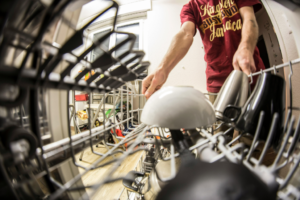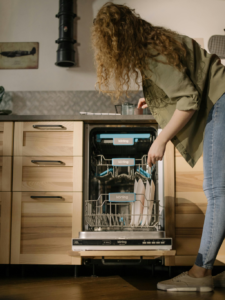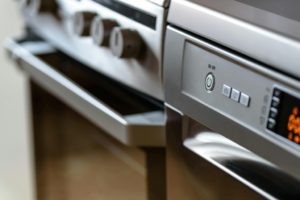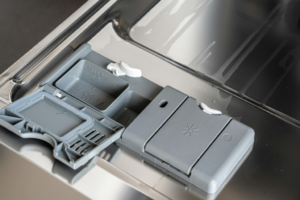Easy Dishwasher Installation Guide to Leak-Free Living

Are you tired of spending hours scrubbing dishes by hand? Say goodbye to the hassle and hello to convenience with a dishwasher. In this guide, we’ll walk you through everything you need to know about dishwasher installation, ensuring a smooth transition to a more efficient kitchen.
Choosing the Right Dishwasher
When it comes to choosing a dishwasher, there are several factors to consider. Think about the size of your kitchen, the number of people in your household, and your budget. Energy efficiency and special features like adjustable racks and sanitizing cycles are also worth considering.

Before making a purchase, measure the space where the dishwasher will go and check the plumbing and electrical requirements to ensure compatibility. For smaller places, there are countertop options. Countertop options for dishwashing are altogether different. What they bring in convenience, they also bring with them, their challenges.
What types of dishes can be washed in a countertop dishwasher?
Countertop dishwashers are a convenient option for those with limited kitchen space or small households. These compact appliances are flexible and can fit on a cabinet or countertop. When it comes to the types of dishes that can be washed in a countertop dishwasher, the options are, for the most part, inclusive of most, if not all, the utensils we use daily.
From plates and glasses to cutlery and small pots and pans, most standard kitchen items can be cleaned in these handy appliances. It is important to follow the manufacturer’s instructions and recommendations for specific items, and it may be necessary to hand wash items that are not dishwasher-safe. To ensure the longevity of your countertop dishwasher, it is also recommended to regularly clean the dishwasher’s interior and exterior surfaces with a damp cloth and to have it serviced by a professional to ensure proper functioning.
Preparing for Installation
Before installing your new dishwasher, clear out the space and remove any old appliances if necessary. Gather the tools and materials you’ll need, including a wrench, screwdriver, and plumber’s tape. Taking these steps beforehand will streamline the installation process and minimize disruptions to your routine.
Assessing Plumbing and Electrical Requirements

Before beginning installation, it’s essential to assess the plumbing and electrical requirements of your new dishwasher. Make sure you have access to a water supply and drainage for the dishwasher, as well as a dedicated electrical outlet if required. Shut off the water and electricity in the area before starting work to ensure safety. Usually, when simply replacing an older built-in dishwasher with a newer model, the necessities will be in place. But, it will pay handsome dividends up front to do your homework.
How far away can a dishwasher be from the sink?
When it comes to determining how far away a dishwasher can be from the kitchen sink, there are a few factors to consider. Ideally, the dishwasher should be located within a few feet of the sink faucet to make it more convenient for loading and unloading dishes.
It is also important to ensure that the dishwasher is built-in rather than a portable unit to prevent water leaks and potential clogs in the future. Having the dishwasher closer to the sink can help prevent the buildup of residue and make it easier to monitor for any potential issues that may arise.
Additionally, a reliable and neat installation can help prevent the need for costly repairs or replacements down the line. If you are unsure about how to properly install a dishwasher or consider replacing an existing one, it may be necessary to need a professional for guidance.
Installation Steps
Now it’s time to install your new dishwasher. Start by shutting off the water and electricity to the area. Connect the water supply and drainage hoses, making sure to use plumber’s tape to create a watertight seal. If your dishwasher requires electrical connections, follow the manufacturer’s instructions carefully. Once everything is connected, secure the dishwasher in place and test for leaks and proper functioning. Do not secure the hardware to keep the washer in place until you are comfortable with all the fittings. It will save you double work if you need to pull the dishwasher back out for some obscure fitting or leak in the back.
Troubleshooting Common Installation Issues
If you encounter any issues during installation, don’t panic. Common problems like leaks or improper fittings can often be resolved with simple adjustments. Refer to the manufacturer’s instructions or seek advice from a professional if needed. Taking the time to troubleshoot now will save you headaches later on. Do not settle for “it will be alright” it could cost you money down the road.
Maintenance Tips for Longevity

To keep your dishwasher running smoothly, it’s essential to perform regular maintenance. Clean the interior and exterior regularly to prevent buildup and odors. Check the filters and spray arms for debris, and run a cleaning cycle with vinegar or a dishwasher cleaner periodically. Following these maintenance tips will help extend the life of your dishwasher and ensure optimal performance.
Benefits of Professional Dishwasher Installation
While DIY installation may seem tempting, there are significant benefits to hiring a professional. Experienced installers can ensure proper setup and address any issues that may arise during the process. Plus, professional installation often comes with a warranty, providing added peace of mind.
Cost Considerations

When budgeting for dishwasher installation, consider both the upfront costs and long-term savings. While DIY installation may save money initially, professional installation can offer greater efficiency and peace of mind. Compare quotes from different installers to find the best value for your budget.
Customer Testimonials and Satisfaction
At Aboveboard Home Services, we take pride in providing quality results at affordable prices. Our satisfied customers rave about the convenience and efficiency of our dishwasher installation services. With personal attention to detail and transparent pricing, we’re here to make your transition to a dishwasher as smooth as possible.
Conclusion

Dishwasher installation doesn’t have to be a hassle. With the right preparation and professional help, you can enjoy the convenience of a dishwasher in no time. Say goodbye to hand washing and hello to more time spent doing the things you love.
Frequently Asked Questions
How do I install a dishwasher properly?
To install a dishwasher correctly, start by ensuring that the sink and drain are ready for installation. You might need a plumber to help with connecting the inlet and drain hose properly. Check the valve and follow the manufacturer‘s instructions to avoid any issues. Make sure to rinse the dishes and remove any food particles before loading them for a wash.
Should I consult a professional to install my dishwasher?
If you are unsure about how to install your dishwasher correctly, it’s best to consult a plumber or technician. They can ensure that the task is done efficiently and that all connections are secure. A licensed professional will also make sure that the dishwasher is conveniently placed and connected to electricity and water with utmost safety.
What should I do if my dishwasher is not working properly?
If your dishwasher is malfunctioning or faulty, you may need to repair or replace certain parts. If you don’t have your manual, more often than not it can be downloaded from your manufacturer’s website. If it is a new install, consult your installer or retailer quickly to ensure they own any problems they missed or caused on the installation. If you fail to identify the issue yourself, do not hesitate to consult an electrician or plumber to diagnose the issue. They can help in replacing any defective or worn-out components like the pump or drain pipe to get your dishwasher running efficiently again.
How do I clean my dishes properly with a dishwasher?
For clean dishes after a cycle, make sure to simply load them correctly in the dishwasher. Avoid overloading to ensure each item is properly washed. Use a quality detergent and follow the manufacturer’s recommendations. Most if not all manufacturers have online manuals for present and many older models online. It can be comical as some people are quite the sticklers about how to properly load a dishwasher. One can learn a lot about someone when loading their dishwasher as a dinner guest trying to help tidy up after dinner.






